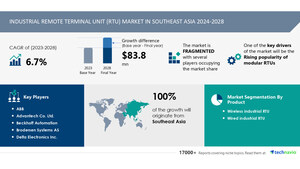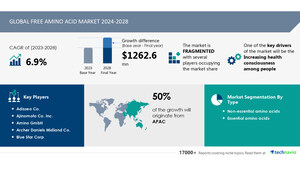NEW YORK, May 13, 2024 /PRNewswire/ -- The global private lte market size is estimated to grow by USD 3.53 bn from 2023-2027, according to Technavio. The market is estimated to grow at a CAGR of 10.35% during the forecast period.
For more insights on the forecast market size and historic data (2017 - 2021) - Buy Report
Forecast period |
2023-2027 |
Growth momentum & CAGR |
Accelerate at a CAGR of 10.35% |
Market growth 2023-2027 |
USD 3.53 billion |
Market structure |
Fragmented |
YoY growth 2022-2023 (%) |
9.88 |
Regional analysis |
North America, Europe, APAC, Middle East and Africa, and South America |
Performing market contribution |
North America at 53% |
Key countries |
US, Canada, China, Japan, and France |
Key companies profiled |
Airspan Networks Holdings Inc., ASOCS Ltd., Boingo Wireless Inc., Casa Systems Inc., Cisco Systems Inc., Comba Telecom Systems Holdings Ltd., CommScope Holding Co. Inc., Druid Software, Fujitsu Ltd., Hewlett Packard Enterprise Co., Huawei Technologies Co. Ltd., L3Harris Technologies Inc., Microsoft Corp., Motorola Solutions Inc., NEC Corp., Nokia Corp., Parallel Wireless Inc., Samsung Electronics Co. Ltd., Telefonaktiebolaget LM Ericsson, and ZTE Corp. |
Market Driver
The private LTE market is experiencing a significant shift towards 5G-capable networks, merging the benefits of 5G and LTE technologies. This fusion enables organizations to leverage faster data rates, ultra-low latency, and expanded network capacity. Key technologies driving this trend include open networking models, cloud, and virtualization. Spectrum regimes, such as licensed, shared, and unlicensed, are crucial in this context. Private LTE networks, supporting industries like IoT, manufacturing, and transportation, are being integrated with 5G infrastructure. Collaborations, like Ericsson and Verizon's, are paving the way for this transformation. Key players are investing in consulting, implementation, and managed services. Frequency division duplexing and time division duplexing are essential in optimizing these networks. Regulatory authorities, MNOs, and auction processes are shaping the landscape of this long-term investment. Industries like utilities, energy, oil and gas, mining, government, public safety, military, and finance are expected to benefit significantly.
Market Challenges
- The private LTE market faces significant challenges due to spectrum availability and licensing complexities. Regulations and frequency allotments vary by region and nation, hindering global deployment and expansion. Keywords such as 800MHz, 1900MHz, industrial IoT, and commercial IoT are impacted by this fragmentation. Navigating the intricate ecosystem of spectrum rules, auctions, and regulatory authorities can delay implementation and deployment of private LTE networks. This inconsistency also affects interoperability and cross-border activities. The ecosystem includes MNOs, government regulatory authorities, and industries like utilities, energy, oil and gas, mining, manufacturing, public safety, military, transportation, logistics, finance, and healthcare. Solutions like consulting services, managed services, frequency division duplexing, time division duplexing, licensed spectrum, unlicensed spectrum, shared spectrum, cloud technology, virtualization, open network models, and 5G networks aim to mitigate these challenges.
Research report provides comprehensive data on impact of trend, driver and challenges - Request a sample report!
Segment Overview
This private lte market report extensively covers market segmentation by
- End-user
- 1.1 Healthcare
- 1.2 Retail and e-commerce
- 1.3 IT and telecom
- 1.4 Others
- Component
- 2.1 Infrastructure
- 2.2 Services
- Geography
- 3.1 North America
- 3.2 Europe
- 3.3 APAC
- 3.4 Middle East and Africa
- 3.5 South America
1.1 Healthcare- In the dynamic landscape of telecommunications, the private LTE market continues to gain traction as an essential enabler for digital transformation across various industries. This market is characterized by the utilization of diverse spectrum regimes, including licensed, unlicensed, and shared spectrum. Licensed spectrum, allocated through a formal auction process by government regulatory authorities, offers predictable bandwidth and QoS, making it an ideal choice for mission-critical applications in the healthcare and education industry verticals. Unlicensed spectrum, on the other hand, provides flexibility and cost savings, making it suitable for commercial IoT and industrial IoT applications. Shared spectrum, such as the Citizens Broadband Radio Service (CBRS) band, offers a middle ground, enabling coexistence and interoperability among multiple network operators. The 5G network, with its open networking model, cloud, and virtualization technologies, further enhances the capabilities of private LTE networks. Spectrum regimes extend to GAA Tier 3 users, who can leverage licensed frequency bands, such as 700 MHz, 800MHz, and 1900MHz, for their private networks. The energy & utility industry, robotics, artificial intelligence, and industrial IoT are among the sectors that can benefit significantly from these investments in long-term licensed frequency. However, challenges such as frequency band interference and security concerns, particularly with the handling of sensitive data, necessitate robust solutions. Network operators must ensure QoS and prioritize security to maintain the trust and confidence of their clients. In conclusion, the private LTE market plays a pivotal role in driving digital transformation across industries, offering a range of spectrum options, and addressing the unique requirements of various sectors. With the ongoing evolution of telecommunications technologies, the market is poised for continued growth and innovation.
For more information on market segmentation with geographical analysis including forecast (2023-2027) and historic data (2017 - 2021) - Download a Sample Report
Research Analysis
The Private LTE market is experiencing significant growth as businesses and industries embrace digital transformation and seek reliable, high-performance communication solutions. Virtualization technologies play a crucial role in the deployment of Private LTE networks, enabling network operators to optimize their spectrum usage and deliver superior Quality of Service (QoS). Spectrum regimes, including licensed and unlicensed spectrum, are essential for Private LTE networks. Licensed spectrum, managed by government regulatory authorities through an auction process, offers dedicated bandwidth and greater security for sensitive data. Shared spectrum and unlicensed spectrum, on the other hand, provide more flexibility and cost-effectiveness for GAA Tier 3 users. Private LTE networks are increasingly being adopted by various sectors, including utilities, energy, oil and gas, mining, manufacturing, and government, to support industrial IoT and commercial IoT applications. Long-term investments in licensed frequency bands, such as 700 MHz, 800MHz, and 1900MHz, are crucial for ensuring the success and scalability of these networks. MNOs and network operators must work closely with industry stakeholders to navigate the complex regulatory landscape and secure the necessary licenses and leases for their Private LTE networks.
Market Research Overview
The Private LTE market is experiencing significant growth due to the increasing demand for secure and reliable wireless communication solutions. With the integration of Long Term Evolution (LTE) technology, private networks offer enhanced capabilities for industries such as manufacturing, healthcare, and transportation. The use of LTE technology enables faster data transfer rates, improved network coverage, and lower latency compared to traditional cellular networks. Moreover, the implementation of LTE networks provides organizations with greater control over their communication infrastructure, ensuring data security and privacy. The Private LTE market is expected to continue its expansion, driven by the need for efficient and secure communication systems. The use of technologies such as Virtualization, SDN, and Cloud computing in Private LTE networks further enhances their capabilities and flexibility. The market is also witnessing the adoption of 5G technology in private networks, offering even faster data transfer rates and lower latency. Overall, the Private LTE market presents a promising opportunity for organizations seeking to enhance their communication infrastructure and ensure data security and privacy.
Table of Contents:
1 Executive Summary
2 Market Landscape
3 Market Sizing
4 Historic Market Size
5 Five Forces Analysis
6 Market Segmentation
- End-user
- Healthcare
- Retail And E-commerce
- IT And Telecom
- Others
- Component
- Infrastructure
- Services
- Geography
- North America
- Europe
- APAC
- Middle East And Africa
- South America
7 Customer Landscape
8 Geographic Landscape
9 Drivers, Challenges, and Trends
10 Company Landscape
11 Company Analysis
12 Appendix
About Technavio
Technavio is a leading global technology research and advisory company. Their research and analysis focuses on emerging market trends and provides actionable insights to help businesses identify market opportunities and develop effective strategies to optimize their market positions.
With over 500 specialized analysts, Technavio's report library consists of more than 17,000 reports and counting, covering 800 technologies, spanning across 50 countries. Their client base consists of enterprises of all sizes, including more than 100 Fortune 500 companies. This growing client base relies on Technavio's comprehensive coverage, extensive research, and actionable market insights to identify opportunities in existing and potential markets and assess their competitive positions within changing market scenarios.
Contacts
Technavio Research
Jesse Maida
Media & Marketing Executive
US: +1 844 364 1100
UK: +44 203 893 3200
Email: [email protected]
Website: www.technavio.com/
SOURCE Technavio

WANT YOUR COMPANY'S NEWS FEATURED ON PRNEWSWIRE.COM?
Newsrooms &
Influencers
Digital Media
Outlets
Journalists
Opted In






Share this article